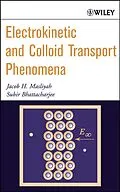A new, definitive perspective of electrokinetic and colloid
transport processes
Responding to renewed interest in the subject of electrokinetics,
Electrokinetic and Colloid Transport Phenomena is a timely overview
of the latest research and applications in this field for both the
beginner and the professional. An outgrowth of an earlier text (by
coauthor Jacob Masliyah), this self-contained reference provides an
up-to-date summary of the literature on electrokinetic and colloid
transport phenomena as well as direct pedagogical insight into the
development of the subject over the past several decades.
A distinct departure from standard colloid science monographs,
Electrokinetic and Colloid Transport Phenomena presents the most
salient features of the theory in a simple and direct manner,
allowing the book to serve as a stepping-stone for further learning
and study. In addition, the book uniquely discusses numerical
simulation of electrokinetic problems and demonstrates the use of
commercial finite element software for solving these multiphysics
problems. Among the topics covered are:
* Mathematical preliminaries
* Colloidal systems
* Electrostatics and application of electrostatics
* Electric double layer
* Electroosmosis and streaming potential
* Electrophoresis and sedimentation potential
* London-Van der Waals forces and the DLVO theory
* Coagulation and colloid deposition
* Numerical simulation of electrokinetic phenomena
* Applications of electrokinetic phenomena
Because this thorough reference does not require advanced
mathematical knowledge, it enables a graduate or a senior
undergraduate student approaching the subject for the first time to
easily interpret the theories. On the other hand, the application
of relevant mathematical principles and the worked examples are
extremely useful to established researchers and professionals
involved in a wide range of areas, including electroosmosis,
streaming potential, electrophoretic separations, industrial
practices involving colloids and complex fluids, environmental
remediation, suspensions, and microfluidic systems.
Autorentext
JACOB H. MASLIYAH, PhD, is a Professor of Chemical Engineering and a University Professor at the University of Alberta, Canada, and has published over 270 papers in the area of transport phenomena. He currently holds the Natural Sciences and Engineering Research Council of Canada Industrial Research Chair in Oil Sands Engineering. He is a Fellow of the Royal Society of Canada and the Canadian Academy of Engineering.
SUBIR BHATTACHARJEE, PhD, is an Associate Professor of Mechanical Engineering and is the Canada Research Chair in Colloids and Complex Fluids at the University of Alberta, Canada. He has published research papers in areas including colloidal interactions and transport, electrokinetic processes, novel separations, microfluidics, and atomic force microscopy.
Klappentext
A new, definitive perspective of electrokinetic and colloid transport processes
Responding to renewed interest in the subject of electrokinetics, Electrokinetic and Colloid Transport Phenomena is a timely overview of the latest research and applications in this field for both the beginner and the professional. An outgrowth of an earlier text (by coauthor Jacob Masliyah), this self-contained reference provides an up-to-date summary of the literature on electrokinetic and colloid transport phenomena as well as direct pedagogical insight into the development of the subject over the past several decades.
A distinct departure from standard colloid science monographs, Electrokinetic and Colloid Transport Phenomena presents the most salient features of the theory in a simple and direct manner, allowing the book to serve as a stepping-stone for further learning and study. In addition, the book uniquely discusses numerical simulation of electrokinetic problems and demonstrates the use of commercial finite element software for solving these multiphysics problems. Among the topics covered are:
- Mathematical preliminaries
- Colloidal systems
- Electrostatics and application of electrostatics
- Electric double layer
- Electroosmosis and streaming potential
- Electrophoresis and sedimentation potential
- London–Van der Waals forces and the DLVO theory
- Coagulation and colloid deposition
- Numerical simulation of electrokinetic phenomena
- Applications of electrokinetic phenomena
Because this thorough reference does not require advanced mathematical knowledge, it enables a graduate or a senior undergraduate student approaching the subject for the first time to easily interpret the theories. On the other hand, the application of relevant mathematical principles and the worked examples are extremely useful to established researchers and professionals involved in a wide range of areas, including electroosmosis, streaming potential, electrophoretic separations, industrial practices involving colloids and complex fluids, environmental remediation, suspensions, and microfluidic systems.
Inhalt
PREFACE.
COPYRIGHT ACKNOWLEDGMENTS.
CHAPTER 1 MATHEMATICAL PRELIMINARIES.
1.1 Units.
1.2 Physical Constants and Conversion Factors.
1.3 Frequently used Functions.
1.4 Vector Operations.
1.5 Tensor Operations.
1.6 Vector and Tensor Integral Theorems.
1.7 References.
CHAPTER 2 COLLOIDAL SYSTEMS.
2.1 The Colloidal State.
2.2 Colloidal Phenomena.
2.3 Stabilization of Colloids.
2.4 Preparation of Colloidal Systems.
2.5 Purification of Sols.
2.6 A Historical Summary.
2.7 Electrokinetic Phenomena in Modern Colloid Science.
2.8 Nomenclature.
2.9 References.
CHAPTER 3 ELECTROSTATICS.
3.1 Basic Electrostatics in Free Space.
3.2 Summary of Electrostatic Equations in Free Space.
3.3 Electrostatic Classification of Materials.
3.4 Basic Electrostatics in Dielectrics.
3.5 Boundary Conditions for Electrostatic Equations.
3.6 Maxwell Stress for a Linear Dielectric.
3.7 Maxwell's Equations of Electromagnetism.
3.8 Nomenclature.
3.9 References.
CHAPTER 4 APPLICATION OF ELECTROSTATICS.
4.1 Two-Dimensional Dielectric Slab in an External Electric Field.
4.2 A Dielectric Sphere in an External Electric Field.
4.3 A Conducting Sphere in an External Electric Field.
4.4 Charged Disc and Two Parallel Discs in a Dielectric Medium.
4.5 Point Charges in a Dielectric Medium.
4.6 Nomenclature.
4.7 Problems.
4.8 References.
CHAPTER 5 ELECTRIC DOUBLE LAYER.
5.1 Electric Double Layers at Charged Interfaces.
5.2 Potential for Planar Electric Double Layer.
5.3 Potential for Curved Electric Double Layer.
5.4 Electrostatic Interaction between Two Planar Surfaces.
5.5 Electrostatic Potential Energy.
5.6 Electrostatic Interactions between Curved Geometries.
5.6.1 The Derjaguin Approximation.
5.7 Models of Surface Potentials.
5.8 Zeta Potential.
5.9 Summary of GouyChapman Model.
5.10 Nomenclature.
5.11 Problems.
5.12 References.
CHAPTER 6 FUNDAMENTAL TRANSPORT EQUATIONS.
6.1 Single-Component System.
6.2 Multicomponent Systems.
6.3 Hydrodynamics of Colloidal Systems.
6.4 Summary of Governing Equations.
6.5 Nomenclature.
6.6 Problems.
6.7 References.
CHAPTER 7 ELECTROKINETIC PHENOMENA.
7.1 Electroosmosis.
…